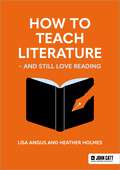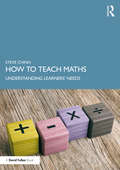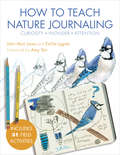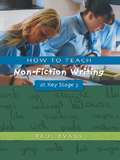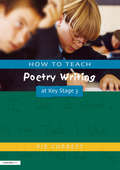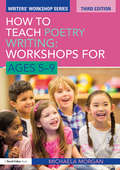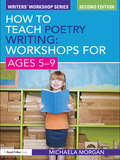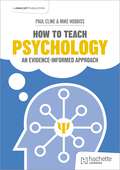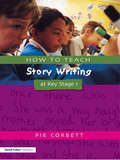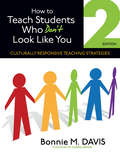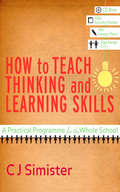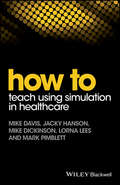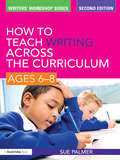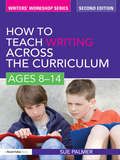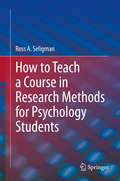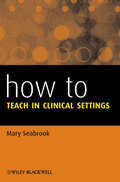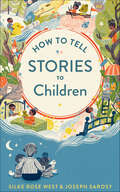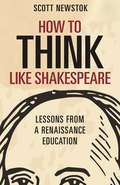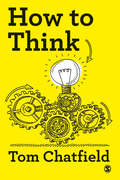- Table View
- List View
How to Teach Literature - and Still Love Reading
by Heather Holmes Lisa AngusIf you're a book lover with a To Be Read list as long as your arm, and you also happen to be a teacher of English literature, How to Teach Literature - and Still Love Reading is the book for you.Written by two experienced teachers and English literature examiners, this book is packed full of inspirational and original reading suggestions from poetry through to drama and prose, together with practical strategies to integrate your reading into the classroom.Aimed at key stage 3 and KS4 teachers, this book will not only help you navigate the perils of external examinations but will also reignite your creativity in the classroom. It will revitalise your teaching and lead to engaging English literature lessons your students will enjoy.As for that TBR list - it's only going to get longer!
How to Teach Literature - and Still Love Reading
by Heather Holmes Lisa AngusIf you're a book lover with a To Be Read list as long as your arm, and you also happen to be a teacher of English literature, How to Teach Literature - and Still Love Reading is the book for you.Written by two experienced teachers and English literature examiners, this book is packed full of inspirational and original reading suggestions from poetry through to drama and prose, together with practical strategies to integrate your reading into the classroom.Aimed at key stage 3 and KS4 teachers, this book will not only help you navigate the perils of external examinations but will also reignite your creativity in the classroom. It will revitalise your teaching and lead to engaging English literature lessons your students will enjoy.As for that TBR list - it's only going to get longer!
How to Teach Maths: Understanding Learners' Needs
by Steve ChinnHow to Teach Maths challenges everything you thought you knew about how maths is taught in classrooms. Award-winning author Steve Chinn casts a critical eye over many of the long-established methods and beliefs of maths teaching. Drawing from decades of classroom experience and research, he shows how mathematics teaching across the whole ability range can be radically improved by learning from the successful methods and principles used for the bottom quartile of achievers: the outliers. Chinn guides readers through re-adjusting the presentation of maths to learners, considering learners’ needs first, and explains the importance of securing early learning to create a conceptual foundation for later success. This highly accessible book uses clear diagrams and examples to support maths teachers through many critical issues, including the following: The context of maths education today Topics that cause students the most difficulty Effective communication in the mathematics classroom Addressing maths anxiety The perfect resource for maths teachers at all levels, this book is especially useful for those wanting to teach the foundations of mathematics in a developmental way to learners of all ages and abilities. It has the potential to change the way maths is taught forever.
How to Teach Nature Journaling: Curiosity, Wonder, Attention
by John Muir Laws Emilie LygrenExpanding on the philosophy and methods of The Laws Guide to Nature Drawing and Journaling, John Muir Laws and Emilie Lygren have developed the first-ever comprehensive book devoted to helping educators use nature journaling as an inspiring teaching tool to engage young people with wild places. In their workshops Laws and Lygren are often asked the how-tos of teaching nature journaling: how to manage student groups in the outdoors, teach drawing skills (especially from those who profess to have none), connect journaling to educational standards, and incorporate journaling into longer lessons. This book puts together curriculum plans, advice, and in-the-field experience so that educators of all stripes can leap into journaling with their students. The approaches are designed to work in a range of ecosystems and settings, and are suitable for classroom teachers, outdoor educators, camp counselors, and homeschooling parents. Full-color illustrations and sample journal pages from notable naturalists show how to put each lesson into practice. Field-tested by over a hundred educators, this book includes dozens of activities that easily support the Common Core and the Next Generation Science Standards—and, just as important, it will show kids and mentors alike how to recognize the wonder and intrigue in their midst.
How to Teach Non-Fiction Writing at Key Stage 3 (Writers Workshop Ser.)
by Paul EvansHow to Teach Non-Fiction Writing at Key Stage 3 is a practical manual to help teachers of 11-14 year-olds to focus on key aspects of developing their pupil's non-fiction writing. The book presents a clear teaching sequence that emphasizes the link between reading and writing, and can raise pupil's attainment levels in both areas. Practical writing workshops focus on the six main types of non-fiction as defined in the NLS Framework for Year 7: information, recount, explanation, instruction, persuasion and discussion texts. Each workshop includes photocopiable sample texts, instructions for teachers, and tasks for pupils to complete. With advice on how to make best use of a writing journal, and how to progress in sentence construction - how to make sentences more flexible and better adapted to purpose - the book is a practical and immediately useful resource for KS3 teachers.
How to Teach Poetry Writing at Key Stage 3
by Pie CorbettHow to Teach Poetry Writing at Key Stage 3 is a practical manual for teachers, to be used directly in the classroom. The book begins with a series of poetry games designed to warm up creativity and strengthen the imagination. These are followed by a series of creative poetry workshops, based on the writer's own experience both as a teacher and poet running workshops in schools, which focus on developing a 'poetry base' for young writers. This imaginative base provides a range of poetic techniques and gives pupils experience in developing a repertoire of different forms. The book also offers advice on how to organize an effective workshop, and demonstrates how to teach poetry writing in a dynamic, creative and imaginative way in relationship with the KS3 national framework. Pie Corbett also provides useful advice on working with visiting poets in school, addresses for relevant web-sites, a list of books for follow-up work and a glossary of poetic forms and techniques. Workshops include writing from first hand observation; autobiography - valuing our lives; writing about paintings, sculpture and music; surreal boxes and the bag of words; secrets, lies, wishes and dreams; creating images, taking word snapshots; riddles - hiding the truth; and red wheelbarrows and messages for mice.
How to Teach Poetry Writing: Developing Creative Literacy (Writers' Workshop)
by Michaela MorganThis fully revised and extended third edition of How to Teach Poetry Writing: Workshops for Ages 8-13 is a practical and activity-based resource of writing workshops to help you teach poetry. Designed to build writing, reading, speaking and listening skills, this new edition contains a wider selection of workshops exemplifying a variety of poetry styles, both classic and contemporary. Highlighting how the unique features of poetry can be used to teach literary skills, this book: Includes new workshops which introduce, or consolidate, Spelling, Punctuation and Grammar skills. Encourages debate, discussion, performance and empathy. Offers a new focus on confidence building and creativity using performance, rhythm, rhyme and rap. Explores the use of poetry for vocabulary enhancement. Encourages reading for pleasure. Provides an A to Z guide to poetry and poetry terminology plus a very extensive bibliography enabling you to keep up to date with poetry and poetry resources. Represents diverse cultures. Highlights cross-curricular links. Promoting creativity, achievement, mastery and enjoyment, How to Teach Poetry Writing: Workshops for Ages 8-13 provides teachers with a wealth of material and the inspiration to create a class of enthusiastic and skilled readers, writers, listeners and performers.
How to Teach Poetry Writing: Workshops For Ages 5-9 (Writers' Workshop)
by Michaela MorganNow in a fully revised third edition, How to Teach Poetry Writing: Workshops for Ages 5–9 is a practical, activity-based resource of poetry writing workshops. Each workshop provides enjoyable activities for pupils, aimed at building enjoyment and understanding of what poetry is and how to write it. Aiming to encourage speaking and listening skills as well as developing writing, this book includes: ● new workshops and a new emphasis on cross curricular links ● spelling, punctuation and grammar approached in an enjoyable and memorable way via poetry redrafting and revising activities; ● poetry writing frames; ● traditional and contemporary poems from diverse cultures; ● children’s own poems on their favourite subjects; ● performance poetry ● word games, nonsense and invented words. ● an A–Z guide to poetry, providing terminology, examples and a fund of further lesson ideas. ● an A to Z guide to poets a very extensive bibliography to encourage further reading and reading for enjoyment. This book provides teachers with a wealth of material and the inspiration to create a class of enthusiastic and skilled readers, writers and listeners.
How to Teach Poetry Writing: Workshops for Ages 5-9 (Writers' Workshop)
by Michaela MorganNow in a fully revised and extended second edition, How to Teach Poetry Writing: Workshops for Ages 5-9 is a practical, activity based resource of poetry writing workshops for teachers of primary age children. Each workshop provides enjoyable activities for pupils aimed at building a thorough understanding of what poetry is and how to write it. Aiming to encourage speaking and listening skills, this book includes: three new workshops - Feelings, Licensed to Thrill and The Jumblies redrafting and revising activities poetry writing frames traditional and contemporary poems from varied cultures children’s’ own poems on their favourite subjects guidance on how to write poems word games and notes on performing poetry an A-Z Guide to Poetry. Updated to include cross-curricular links and a new expansive bibliography, this book provides teachers with a wealth of material andall the necessary skills to create a class of enthusiastic poetry writers.
How to Teach Psychology: An evidence-informed approach
by Paul Cline Mike HobbissPsychology as a subject is more popular in secondary schools than ever before, but achieving deep insights into, and appreciation of, the complexity of human behaviour is a challenge that requires expert guidance and teaching. In addition to teaching the often demanding subject content on their specifications, Psychology teachers must also be experts in inculcating mathematical skills and written communication. All this in students who often start without any prior experience of the subject. This poses serious challenges for teachers' subject knowledge, pedagogy and planning. And yet, until now, little has been written about how to teach Psychology effectively. This book aims to help anyone facing that challenge. Drawing on a wealth of psychological and pedagogical insights, coupled with years of teaching experience, Paul Cline and Mike Hobbiss provide practical advice and concrete suggestions to support Psychology teachers at all levels. From curriculum choices to the minutiae of in-class decisions, from developing as an individual teacher to leading a Psychology department, this book provides the complete, evidence-informed guide to teaching Psychology.
How to Teach Psychology: An evidence-informed approach
by Paul Cline Mike HobbissPsychology as a subject is more popular in secondary schools than ever before, but achieving deep insights into, and appreciation of, the complexity of human behaviour is a challenge that requires expert guidance and teaching. In addition to teaching the often demanding subject content on their specifications, Psychology teachers must also be experts in inculcating mathematical skills and written communication. All this in students who often start without any prior experience of the subject. This poses serious challenges for teachers' subject knowledge, pedagogy and planning. And yet, until now, little has been written about how to teach Psychology effectively. This book aims to help anyone facing that challenge. Drawing on a wealth of psychological and pedagogical insights, coupled with years of teaching experience, Paul Cline and Mike Hobbiss provide practical advice and concrete suggestions to support Psychology teachers at all levels. From curriculum choices to the minutiae of in-class decisions, from developing as an individual teacher to leading a Psychology department, this book provides the complete, evidence-informed guide to teaching Psychology.
How to Teach Story Writing at Key Stage 1
by Pie CorbettHow to Teach Story Writing at Key Stage 1 is a practical manual for teachers, to be used directly in the classroom. The book begins with a series of language games, designed to warm up creativity and strengthen the imagination. This is followed by a series of creative story workshops, based on the writer's own experience both as a teacher and poet
How to Teach Students Who Don't Look Like You: Culturally Responsive Teaching Strategies
by Bonnie M. DavisEngage diverse learners in your classroom with culturally responsive instruction! This second edition includes new or expanded coverage of Latino students, ELLs, immigrant students, race, and racial identity, and new coverage of standards-based, culturally responsive lesson planning and instruction, differentiated instruction, RTI, and the Common Core State Standards. Bonnie Davis helps all educators: Tailor instruction to their unique student population Reflect on their cultures and how this shapes their views of the world Cultivate a deeper understanding of race and racism in the U.S. Create culturally responsive instruction Understand how culture affects learning
How to Teach Thinking and Learning Skills: A Practical Programme for the Whole School
by C J SimisterIncludes Online Resources ′The author puts into perspective the importance of teaching thinking and learning skills providing clear explanations and easy to follow activities that can be used as a series of lessons, or simply as a one off. As a resource for the primary practitioner it is both practical and informative′ - ESCalate ′A treasure-trove of practical resources to stretch young people′s thinking muscles!′ - Professor Guy Claxton, University of Bristol ′It is full of useful ideas for busy teachers and helpful in getting the children rather than the teachers to do the thinking in the classroom′ - Professor Robert Fisher, Brunel University By helping children to form positive thinking and learning habits, and to develop a range of transferable skills, we give them the tools they need to become successful learners. This book is grounded in the best of current practice and theories surrounding thinking and learning skills. It provides a highly effective method for introducing a comprehensive set of thinking and learning skills to children aged 5 to 11, as well as for integrating these skills through the curriculum. By means of carefully developed games, activities and group tasks, these ready-to-use lessons will appeal to a wide range of learners and abilities. Features of the book include: - a clear explanation of what thinking and learning skills are; - lots of photocopiable activities, for use by individual teachers and in INSET; - a plan for introducing thinking and learning skills in your school; - suggestions for further reading and development of the programme. Headteachers, Curriculum Co-ordinators and classroom practitioners wishing to introduce and develop thinking and learning skills in their school can either follow this programme in its entirety, or dip into it when appropriate for specific activities.
How to Teach Using Simulation in Healthcare
by Mike Davis Jacky Hanson Lorna Lees Mark Pimblett Mike DickinsonHow to Teach Using Simulation in Healthcare provides an ideal introduction and easy-to-use guide to simulation in medical education. Written by a team of experienced medical educators, this practical text – packed full of case examples and tips – is underpinned by the theory of simulation in education, and explores how to integrate simulation into teaching. Key topics include: Use of low, medium and high fidelity equipment Issues of simulation mapping and scenario design Role of human factors Formative and summative assessment New social media and technologies Detailed explorations of some examples of simulation. How to Teach Using Simulation in Healthcare is invaluable reading for all healthcare professionals interested and involved in the origins, theoretical underpinnings, and design implications of the use of simulation in medical education.
How to Teach Writing Across the Curriculum: Ages 6-8 (Writers' Workshop)
by Sue PalmerNow in an updated second edition How to Teach Writing Across the Curriculum: Ages 6-8 provides a range of practical suggestions for teaching non-fiction writing skills and linking them to children’s learning across the entire curriculum. Providing a number of suggestions for teachers and putting emphasis on creative approaches to teaching children writing in diverse and innovative ways, it provides: techniques for using speaking and listening, drama and games to prepare for writing suggestions for the use of cross-curricular learning as a basis for writing planning frameworks and ‘skeletons’ to promote thinking skills information on key language features of non-fiction texts examples of non-fiction writing guidance on the process of creating writing from note-making. With new hints and tips for teachers and suggestions for reflective practice, How to Teach Writing Across the Curriculum: Ages 6-8 will equip teachers with all the skills and materials needed to create enthusiastic non-fiction writers in their primary classroom.
How to Teach Writing Across the Curriculum: Ages 8-14 (Writers' Workshop)
by Sue PalmerNow in an updated second edition How to Teach Writing Across the Curriculum: Ages 8-14 provides a range of practical suggestions for teaching non-fiction writing skills and linking them to children’s learning across the curriculum. Emphasising creative approaches to teaching children’s writing in diverse and innovative ways, it provides: information on the organisation and language features of the six main non-fiction text types (recount, report, instruction, explanation, persuasion and discussion) suggestions for the use of cross-curricular learning as a basis for writing planning frameworks for children to promote thinking skills advice on developing children’s writing to help with organisational issues – paragraphing and layout, and the key language features examples of non-fiction writing suggestions for talk for learning and talk for writing (including links to 'Speaking Frames'; also published by Routledge) information on the transition from primary to secondary school. With new hints and tips for teachers and suggestions for reflective practice as well as a wealth of photocopiable materials, How to Teach Writing Across the Curriculum: Ages 8-14 will equip teachers with all the skills needed to create enthusiastic non-fiction writers in their classroom.
How to Teach Your Children Shakespeare
by Ken LudwigA foolproof, enormously fun method of teaching your children the classic works of William Shakespeare, by a Tony Award–winning playwright—now featuring two new chapters &“You and your children will be transformed by the magic and mystery of Shakespeare and his stories in an instant.&”—Sir Derek Jacobi, CBE Winner of the Falstaff Award for Best Shakespeare BookTo know some Shakespeare provides a head start in life. His plays are among the great bedrocks of Western civilization and contain the finest writing of the past 450 years. Many of the best novels, plays, poems, and films in the English language produced since Shakespeare&’s death in 1616—from Pride and Prejudice to The Godfather—are heavily influenced by Shakespeare&’s stories, characters, language, and themes. In How to Teach Your Children Shakespeare, acclaimed playwright Ken Ludwig provides the tools you need to inspire an understanding, and a love, of Shakespeare&’s works in your children, and to have fun together along the way.Ken Ludwig devised his friendly, easy-to-master methods while teaching his own children. Beginning with memorizing short passages from the plays, his technique then instills children with cultural references they will utilize for years to come. Ludwig&’s approach includes understanding of the time period and implications of Shakespeare&’s diction as well as the invaluable lessons behind his words and stories. Colorfully incorporating the history of Shakespearean theater and society, How to Teach Your Children Shakespeare guides readers on an informed and adventurous journey through the world in which the Bard wrote.This book&’s simple process allows anyone to impart to children the wisdom of plays like A Midsummer Night&’s Dream, Twelfth Night, Macbeth, and Romeo and Juliet. And there&’s fun to be had throughout. Shakespeare novices and experts and readers of all ages will each find something delightfully irresistible in How to Teach Your Children Shakespeare.
How to Teach a Course in Research Methods for Psychology Students
by Ross A. SeligmanThis book is a step-by-step guide for instructors on how to teach a psychology research methods course at the undergraduate or graduate level. It provides various approaches for teaching the course including lecture topics, difficult concepts for students, sample labs, test questions, syllabus guides and policies, as well as a detailed description of the requirements for the final experimental paper. This book is also supplemented with anecdotes from the author’s years of experience teaching research methods classes. Chapters in this book include information on how to deliver more effective lectures, issues you may encounter with students, examples of weekly labs, tips for teaching research methods online, and much more. This book is targeted towards the undergraduate or graduate professor who has either not yet taught research methods or who wants to improve his or her course. Using step by step directions, any teacher will be able to follow the guidelines found in this book that will help them succeed.How to Teach a Course in Research Methods for Psychology Students is a valuable resource for anyone teaching a quantitative research methods course at the college or university level.
How to Teach in Clinical Settings
by Mary SeabrookHow to Teach in Clinical Settings is a practical guide to support all doctors wishing to develop their skills in clinical teaching and supervision.It provides hands on strategies to address common problems such as giving critical feedback effectively and teaching mixed-level groups. It gives guidance on the particular challenges of teaching in clinical settings including the need to manage teaching with service provision, to engage patients, motivate students, and to judge the balance of support and independence appropriate for each trainee.How to Teach in Clinical Settings is invaluable for all doctors involved in teaching and training at any stage of their career. It is also useful and accessible to medical students who increasingly need to consider and develop their own teaching skills as part of their career progression.
How to Tell Stories to Children: And Everyone Else Too
by Joseph Sarosy Silke Rose WestStorytelling is one of the oldest and most essential skills known to humankind, a timeless parenting tool that helps families celebrate life&’s joys, navigate its challenges, and raise healthy, well-adjusted kids. Stories help children manage their emotions, empathize with others, and better understand the complex world we live in. More importantly, storytelling cultivates a rich and meaningful bond between storyteller and listener, building intimacy and trust between parent and child. In this delightful book, Silke Rose West and Joseph Sarosy—early childhood educators with thousands of storytelling hours between them—distill the key ingredients of storytelling into a surprisingly simple method that can make anyone an expert storyteller. Their intuitive technique uses events and objects from your child&’s daily life to make storytelling easy and accessible. By shifting the focus from crafting a narrative to strengthening your relationship with your child, this book will awaken skills you never knew you had. Complete with practical advice, helpful prompts, and a touch of science to explain how stories enrich our lives in so many ways, How to Tell Stories to Children is a must-read for parents, grandparents and educators.
How to Think About God: A Guide for the 20th-Century Pagan
by Mortimer J. AdlerDr. Adler, in his discussion, extends and modernizes the argument for the existence of God developed by Aristotle and Aquinas. Without relying on faith, mysticism, or science (none of which, according to Dr. Adler, can prove or disprove the existence of God), he uses a rationalist argument to lead the reader to a point where he or she can see that the existence of God is not necessarily dependent upon a suspension of disbelief. Dr. Adler provides a nondogmatic exposition of the principles behind the belief that God, or some other supernatural cause, has to exist in some form. Through concise and lucid arguments, Dr. Adler shapes a highly emotional and often erratic conception of God into a credible and understandable concept for the lay person.
How to Think like Shakespeare: Lessons from a Renaissance Education (Skills For Scholars Ser.)
by Scott NewstokA lively and engaging guide to vital habits of mind that can help you think more deeply, write more effectively, and learn more joyfullyHow to Think like Shakespeare offers an enlightening and entertaining guide to the craft of thought—one that demonstrates what we've lost in education today, and how we might begin to recover it. In fourteen brief, lively chapters that draw from Shakespeare's world and works, and from other writers past and present, Scott Newstok distills vital habits of mind that can help you think more deeply, write more effectively, and learn more joyfully, in school or beyond.Challenging a host of today's questionable notions about education, Newstok shows how mental play emerges through work, creativity through imitation, autonomy through tradition, innovation through constraint, and freedom through discipline. It was these practices, and a conversation with the past—not a fruitless obsession with assessment—that nurtured a mind like Shakespeare's. And while few of us can hope to approach the genius of the Bard, we can all learn from the exercises that shaped him.Written in a friendly, conversational tone and brimming with insights, How to Think like Shakespeare enacts the thrill of thinking on every page, reviving timeless—and timely—ways to stretch your mind and hone your words.
How to Think: Your Essential Guide to Clear, Critical Thought
by Tom ChatfieldThis is a book about thinking. Engaging and down-to-earth, it captures the habits and practices that are fundamental to clear thinking and effective study. In his warm and friendly style, Tom Chatfield shows you how to: Identify and examine your biases Engage in lively, curious skepticism See the value in emotion and use rhetoric persuasively Know when to say ′I don′t know′ Construct reasoned arguments and explanations Think critically about how you engage with technology. Short and punchy, the book views critical thinking as a skill to be continually practiced and developed. It equips you with a toolkit for clearer thinking, describing ten key concepts that help you to apply what you have learned. Including regular reflective exercises, key concepts, further readings, each chapter also offers recommendations for how to put the ideas it discusses into practice. This book is for undergraduate students and anyone looking to understand the core ideas behind critical thinking. Celebrating both self-reflection and collaboration, this book empowers you to pause, think twice and, above all, think well.
How to Think: Your Essential Guide to Clear, Critical Thought
by Tom ChatfieldThis is a book about thinking. Engaging and down-to-earth, it captures the habits and practices that are fundamental to clear thinking and effective study. In his warm and friendly style, Tom Chatfield shows you how to: Identify and examine your biases Engage in lively, curious skepticism See the value in emotion and use rhetoric persuasively Know when to say ′I don′t know′ Construct reasoned arguments and explanations Think critically about how you engage with technology. Short and punchy, the book views critical thinking as a skill to be continually practiced and developed. It equips you with a toolkit for clearer thinking, describing ten key concepts that help you to apply what you have learned. Including regular reflective exercises, key concepts, further readings, each chapter also offers recommendations for how to put the ideas it discusses into practice. This book is for undergraduate students and anyone looking to understand the core ideas behind critical thinking. Celebrating both self-reflection and collaboration, this book empowers you to pause, think twice and, above all, think well.
